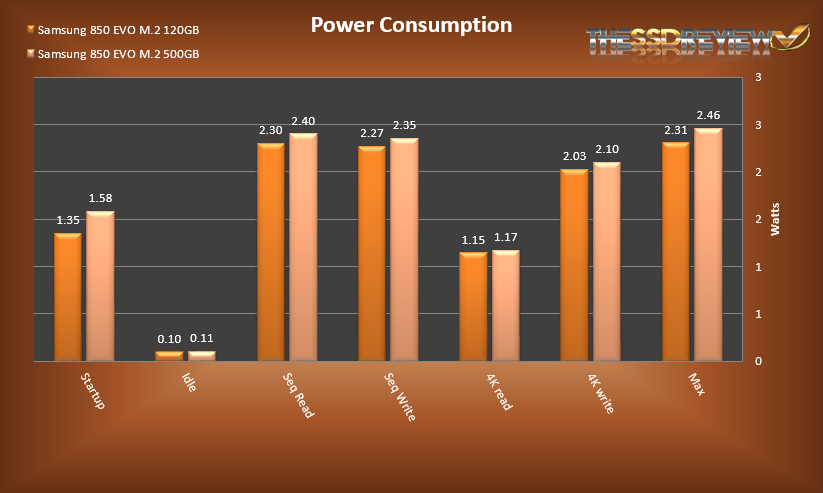POWER CONSUMPTION
For our power consumption testing, we have the drive connected to the system as a secondary drive. To record the wattage, we use an Amprobe AM-270 multimeter connected in line with the 5v power on our SATA power cable to the drive. The multimeter records the min/max amperage draw from the drive over our testing period.
We also record the drive’s sequential and random read and write power draw using Iometer. We then take the values recorded and calculate the wattage of the drive. Some of the results may seem high compared to a standard notebook HDD because as these are peak values under load. When we see average power draw, SSDs are still more power efficient because they only hit max power for a short period of time.
The read and write are really similar in both capacities in terms of power consumption during all tests even though the 500GB is rated for 1.1W over the 120GB. The 120GB comes relatively close to the rated watts (2.4W) for the sequential read and writes. However, the idle watts are much lower coming in at only a little over one-fifth than the rated. This is very good to see as these M.2 form factor SSDs are meant to sip as little power as possible while still providing great performance to the end consumer.
REPORT ANALYSIS AND FINAL THOUGHTS
Samsung has recently been the leader of value for SSDs. Through the technology of their new TLC 3D V-NAND, they are making consumer SSDs that are affordable and high quality for all ranges of users. Coupled along with their increased warranty from 3 to 5 years it shows how much confidence Samsung has in their latest products.
Consistency, this one word describes the performance of the Samsung 850 EVO M.2. When we looked at the PCMark 8 results we saw that the average bandwidth, average latency, and total latency for both capacities were like a solid line relative to the Kingston. Both ATTO and Crystal Disk Mark showed that the 850 EVO M.2 surpassed its sequential read and write ratings. The write speeds for both benchmarks and capacities were about 20MB/s above their ratings. In contrast, the read for ATTO was only 10MB/s higher than it was rated for. Furthermore, they did manage to achieve the rated random 4K IOPS through testing with Iometer. Comparing the M.2 to the 2.5″ form factor of the 850 EVO, they are almost identical, which goes to show how much effort Samsung has gone to keep the performance the same across all form factors.
When it comes down to the M.2 form factor’s size and weight it is most suited for laptops and notebooks. However, its small PCB doesn’t detract from the performance of the 850 EVO M.2 like other M.2’s suffer when scaled down with less NAND chips. This is no small feat that Samsung has pulled off and by doing this it has opened the way for future developments and the shrinking of SSDs even more. Because of this and the performance we have seen here today, we award the Samsung 850 EVO M.2 SATA SSD with our Gold Seal.
 The SSD Review The Worlds Dedicated SSD Education and Review Resource |
The SSD Review The Worlds Dedicated SSD Education and Review Resource | 


Anandtech had a Review today there they said that they can´t recomend it becouse of that it slows down sometimes here i found no problem in the review
That’s what is great about independent reports. If we would have noticed such, it would have been posted and, in fact, , would have been more than evident in PCMark tests which span just under 24 hours of pushing the SSDs nonstop.
Probably you didn’t read either review since anandtech refers to the 1tb msata model only, and this review isn’t about the 1tb msata model .
Ah sorry it was the 1Tb 850 Msata not the M.2 But it also have been quiet about the problem with 840 eco and pro for a long time now
I am sorry but I have a question before purchasing I am considering to upgrade my Samsung notebook series 9 plus that with 128gb m2 which manufacture by Toshiba. Will this fit into the slot, well I took it out once, it look to me that about the same size and the slot is fit by the picture but I just want to make sure because I do not like to buy and return. Thank you
It depends on the allowable form factor. There are multiple sizes that vary in length. The most common are 2260 and 2280.
So this runs over SATA 3? Isn’t that limited to 6GB rather than the 10GB ?
I believe so, if author can confirm that would be gr8.
https://www.guru3d.com/articles-pages/intel-750-nvme-1-2-tb-pcie-ssd-review,8.html
are these easy to boot from? I would say yes if they still use the sata port right?
One observed characteristic of the 120 GB board is that when writing a large file (4.7 GB), the first 1GB of data writes at 500 MB/s but the speed drops to 150 MB/s for the remaining 3.7 GB. Reads occur at full speed. The larger capacity boards don’t seem to have this problem.